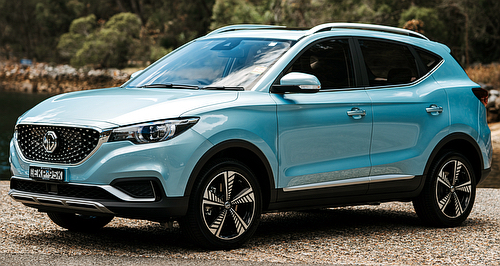Trickle charge: Australian electrified vehicle uptake is slow but accelerating, helped by the arrival of more affordable options such as the MG ZS EV.
Gallery

Click to see larger images
NEW vehicle sales in Australia are rising but electric vehicle (EV) and low-emission vehicle sales are outpacing this growth, showing buyers are accepting new technology but more importantly, car-makers are introducing new electrified models at more affordable prices.
The Australian year-to-date new-vehicle market is up 22.7 per cent. Sales of EVs, however, are up 65.8 per cent and plug-in hybrid (PHEV) sales are up 52 per cent.
Acknowledgement of the electrified end of the market has been aided by more models and is especially true of the newer Chinese brands.
MG has its ZS EV at $44,990 driveaway but other Chinese makers have announced they will follow MG into Australia and leverage China’s lower production cost to lure buyers from conventionally fuelled cars.
In Europe, which had a massive EV and low-emission (hybrid and PHEV) vehicle uptake, the situation is slightly different to Australia.
JATO Dynamics, which provides analytical reports on global vehicle sales and trends, notes that new-car registrations in Europe fell in July following four months of growth.
However, EV and PHEV sales scored their best-ever July result and the second-highest monthly market share this year.
European sales for July were down 24 per cent on the same month in 2020.
However, while total sales were down, more low-emission vehicles were sold. In July, a total of 160,646 EV and PHEV models were registered in Europe, accounting for almost 17 per cent of total registrations.
JATO said this was “the second highest monthly market share after June 2021, and the third highest ever in Europe – EVs accounted for 47 per cent of that total”.
Of the European market, JATO Dynamics global analyst Felipe Munoz said: “Consumers continue to respond positively to the deals and incentives attached to EVs, which have made these vehicles far more competitive in terms of their pricing.
“But despite becoming increasingly popular, consumer uptake has not been enough to offset the big drops posted by diesel cars.”
JATO data indicates that between July 2019 and July 2020, the market share for diesel vehicles dropped by just over two points, while their market share dropped by almost eight points between July 2020 and July 2021.
During the same period, the market share for EVs in Europe grew by the same amount lost by diesel vehicles.
The position is not the same in Australia, where the ute and SUV-driven market is dominated by diesel engines. Diesel vehicle sales are up 36.7 per cent this year to date, compared with the same eight months of 2020, and diesel fuel is used in 33 per cent of new vehicles.
European market share for petrol cars has steadily declined from 63.4 per cent in July 2019 to 59.8 per cent in July 2020, then to 59.0 per cent last month.
In Australia, the petrol-fuelled vehicle segment is 55 per cent of the total market. Sales of petrol vehicles are up 20.9 per cent on last year.
“We are beginning to see the impact of campaigns that favour EVs over ICE vehicles play out in the market, however the industry is not yet doing enough to enable EVs to absorb the losses sustained by traditional powertrains,” Mr Munoz said.
Diesel sales in Europe fell by 166,000 units between July 2020 and July 2021, and almost 207,000 between July 2019 and July 2021.
At the same time, EVs gained 49,000 units between July 2020 and July 2021, and 125,000 units between July 2019 and July 2021.
While the trend towards EVs and PHEVs is strengthening in Europe and Australia, local experience shows the movement is slower.
Much of this is to do with the subsidies available in different European nations, but also the wider range of electrified models there, which gives consumers greater choice.













Facebook Twitter Instagram